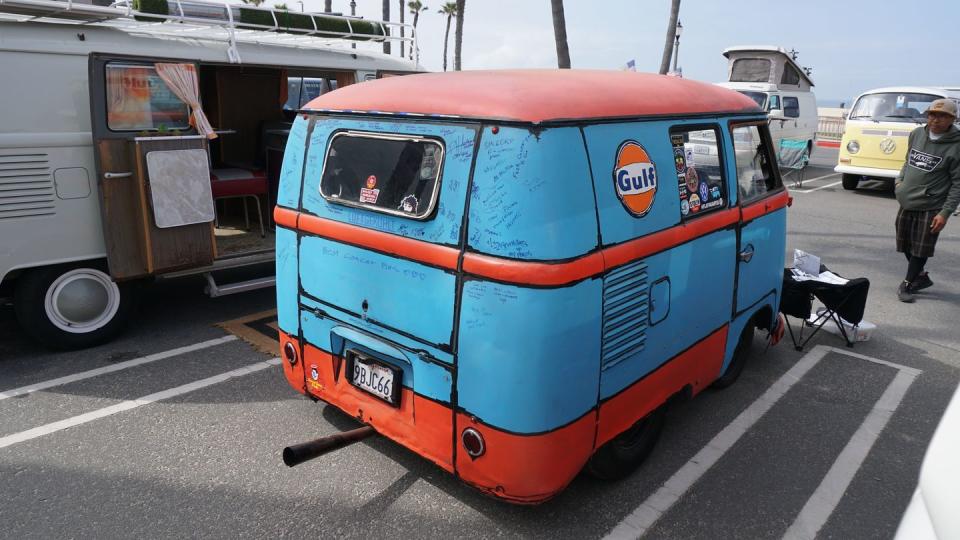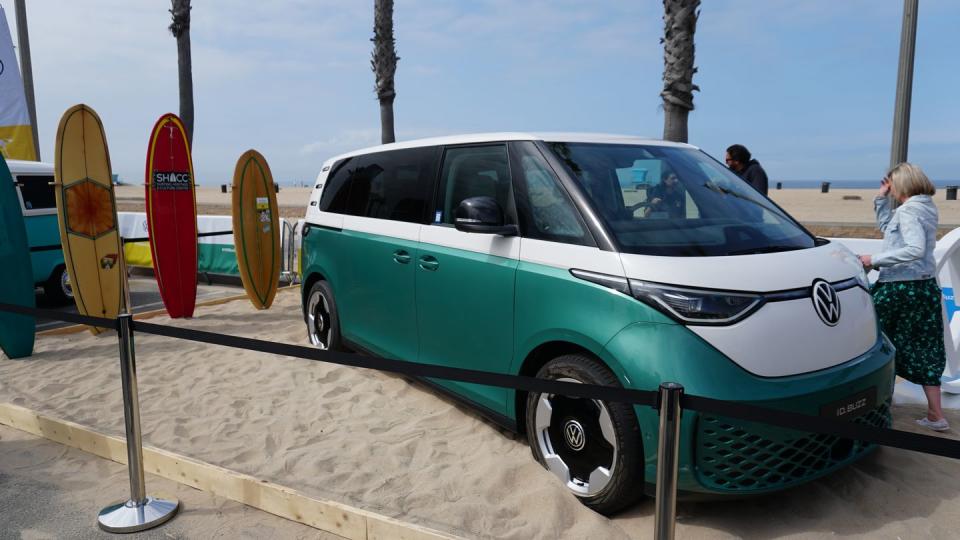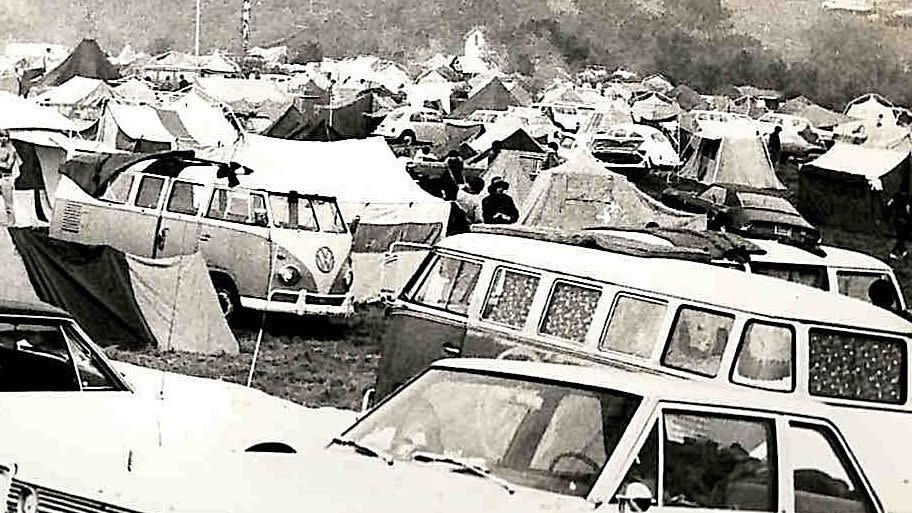VW’s Microbus—and Its Woodstock Legacy—Paves the Way for ID. Buzz

Damon Ristau knows Volkswagens. Not only did he direct two documentaries about them—The Bug: Life and Times of the People’s Car (2016) and The Bus (2012), but he’s also had a lifetime personal passion for the VW Microbus, a/k/a Transporter, Type 2, and Kombi. The car’s retro electric successor, the ID. Buzz, is scheduled to go on sale in the US as a 2025 model next summer.
“At 16, I bought a beat-up 1968 Microbus. I was a wanna-be hippie,” Ristau said. “And as a teenager I was able to change the oil and keep up the maintenance. It was a joyful few years. I had it from sophomore to senior year of high school, and used to pack the whole cross-country team into it for runs.”
After high school, to his parents’ horror, Ristau turned down a scholarship to the University of Montana and drove the bus—by now converted to a Westfalia camper—to Mexico and had adventures.
When he got back to Spokane, the bus was promptly totaled by a drunk driver, but the good memories remained. He later bought an abandoned 1974 Westfalia for $80, fixed it up, and subsequently sold it to an eager buyer in France.

The second-generation VW van, the T2, was sold in the US from 1967 to 1979.

They were made around the world but we got ours from Germany, specifically from two plants, one in Hannover and one in Emden.

The Surfing Heritage and Culture Center in San Clemente loaned some historic surfboards to the ID. Buzz debut.

The Surfing Heritage and Culture Center has everything from Duke Kahanamoku's boards to Bruce Brown's 16mm camera and tripod.

The first VW van is often credited to Belgian importer Ben Pond, but Pond actually saw a jury-rigged Type 1 Beetle that had been converted to a sort of parts hauler at the factory. History does not record who made that.

Because the van was Volkswagen's second model, after the Beetle, it was given the moniker Type 2.

A T2 Westfalia camper.

The first-gen vans come with many different configurations, but the most valuable ones have the most windows. The base models had 11 windows, others had 13, 21, and 23 windows.

The character Fillmore in the Cars movies was based on a VW van.

This dog was chasing after this little RC bus, barking its dog head off.

The dog then retreated to his own VW van.

The vans are often associated with hippies.

This Type 2 van was named Spencer.

Volkswagen subcontracted the modifications to the company Westfalia-Werke in Rheda-Wiedenbrück.

For a while, in the 1960s and '70s, people would cut the middle out of the vans to create these. Note the Gulf Oil livery.

Here it is from the other side.

The Westfalia conversions offered everything you'd need to live in, or camp in, your van.

The fourth-generation T4 was sold in the US from 1990 to 2003.

Peace, man!

This T1 had doors on both sides.

Fillmore had a late night...

The first-gen vans had a wide range of engines, from a 1.1-liter, 2-liter, 5-liter, and even a 6-liter sold only in Brazil. None made enough horsepower.

Instead of crumple zones, the T1 offered the legs of occupants.

Is it right to modify the ride height like this, or is it blasphemy?

This ambulance was at Amelia Island this year, complete with fake patient.

The new, US-spec ID. Buzz rolled onto stage.

All ID. Buzzes will come with two-tone paint jobs.

This is the actual parts truck used by the Meyers Manx factory.

This Vanagon belongs to the great Freeman Thomas, car designer.

The first Westfalia campers had these square poptops.

This one had a winch in front and rugged off-road tires.

Note the cool mount for the Coleman lantern.


Peace, man!

These guys had quite the sound setup.





Pickup trucks and dual cabs were just two of the configurations.








Now Ristau owns a 1985 Westfalia camper. “I have four kids, and we’ve had all six of us sleeping in the VW,” he said. “We put a cot over the front seats. These old VW vans drive like no other vehicle, and they can turn on a dime. I think VW has done a good job with the ID. Buzz—it’s a modern car but they’ve kept the nostalgic charm.”
That charm has attracted celebrity collectors. Actor Ewan McGregor, whose parents had a Beetle when he was a kid, owns a 1958 Transporter and two 1967 Volkswagen Westfalia camper vans, among many other examples of the company’s products.
Microbuses Were Rampant at Yasgur’s Farm
He converted a 1954 oval-window Beetle to electric via specialist EV West, and is looking forward to the ID. Buzz he has on order. “Fewer CO2 emissions and a smaller footprint—for the sake of my children and for future generations,” he said. “That’s pretty cool.”
Another major collector is comedian Gabriel Iglesias, a/k/a Fluffy, whose huge assemblage of Microbuses (worth a reported $3 million) includes passenger versions, panel trucks, pickups, and campers.

No purist, he’s got buses with Subaru engines and buses converted to electric. He paid $700 for his first 1968 example, and describes his collection as “Disneyland for people who love Volkswagen.”
I never owned a Microbus, though I did have a mechanically similar pale blue ’67 Squareback station wagon that was fairly dependable until rust led to the battery falling through the floor.
Around that same time, at 17, with the Squareback dead and a red 1962 Chevy Nova convertible secured, my twin and I drove to the Woodstock Music Art Fair.

If any proof were needed that Microbuses were rampant on the grounds, take a look at my previously unpublished photo above. Is there two or three buses visible, not to mention a few Beetles?
The Grateful Dead weren’t happy with their set at Woodstock, but their presence in the muddy field among Microbuses is ingrained in the minds of hippies and ex-hippies alike. When Jerry Garcia died, VW ran an ad showing the prow of a Microbus weeping a single tear. Did Jerry ever own a Microbus? Some sources said he owned an orange 1960s example, but it isn’t confirmed. He was definitely into old Volvos, and had both a 122S and 1800ES.
An iconic Microbus at Woodstock was an 11-window 1963 Type 2 Deluxe called “Light” and painted in vivid cosmic patterns. A famous photo distributed by Associated Press showed a pair of hippies sitting on its roof.
A 1963 Replica Microbus Gets a Special Paint Job
The 1969 artist Dr. Bob Hieronimus was on hand when, to celebrate the 50th anniversary of the festival, a replica ’63 (the original had rusted away after doing commune duty) was painted by hand to reproduce the long-gone original.
That car was exhibited at Amelia Island Concours earlier this year, with an ID. Buzz and some working examples of the Transporter.

“My friend, Bob Grimm commissioned the painting on it so he would have something eye-catching and meaningful in which to drive himself, with his fellow musicians and their gear, to their performances,” Hieronimus said.
“He named it after his band, Light, and it was with friends and fellow bandmates that he drove it up to Woodstock the following year.” As to the painting, he says, “It’s not psychedelic—it’s symbolic.” The van inspired a documentary, The Woodstock Bus.

Julia Fell, curator of exhibits at the Museum of Bethel Woods, which maintains an extensive Woodstock archive, told Autoweek that of 1500 attendees polled, 75% used personal vehicles to get to the site. Of that number, an amazing 45% “reported using a Volkswagen of any model.”
V-Shaped Windshield for Better Aero
Even further, within that group, “42% specifically described using a VW bus or van.” That means a Microbus was transportation for lots of Woodstockers.
My friends bought Microbuses for $100, shoehorned new engines into them (four bolts led to removal), and drove the wheels off them.
A little history. Ben Pon was an early Dutch Volkswagen dealer in 1947, and an ambitious one. He first tried to start importing Beetles into the US, and when that didn’t initially work out he came up with another idea.

After visiting Wolfsburg and seeing the makeshift transporters on the Bug platform that workers were using in the plant, he penned a sketch for a more sophisticated cargo van that could sit on the chassis.
Pon may have been influenced by innovative designs such as the Buckminster Fuller Dymaxion or the Stout Scarab, but, in any case, his design is not far from the realized Microbus. The engine was still in the back, and driver and passenger sat right up front.
VW was under postwar British administration, and the idea was met with enthusiasm. A new ladder-frame chassis was built, and what was known as the Bulli in Germany (a name revived for some ID. Buzz prototypes) went into production at the end of 1949 as a 1950 model.
When initial prototypes did poorly in wind tunnel testing (0.75 Cd!), the decision was made to split the windshield and roofline in a V-formation. Initially, there were two models, the Kombi with two side windows and two rows of removable seats, and the Commercial.
The Microbus and the Deluxe Microbus followed in May 1950 and June 1951 respectively. Soon after that an ambulance entered the fray, and then a pickup in the summer of 1952.
Would You Convert a Microbus to EV Power?
Eventually there was the panel van, the Westfalia camper, and the upscale Samba, with up to 23 windows and an optional fabric sunroof. These are the most valuable Microbus models today, commanding $200,000 or more when restored.
The first-generation Microbus lasted through 1967. The second-generation got more power and retains some charm, though not quite as much.
Michael Bream, proprietor of Santa Monica, California-based EV West, sells EV drivetrains and converts classic cars to battery power—including a lot of those early Volkswagen buses. “I own three of them myself,” Bream told Autoweek. “The bus is a fantastic platform for an EV conversion.”
Bream, who said Ewan McGregor loves driving his electric Beetle, believes the release of the ID. Buzz will actually lead to more people—not less—wanting to convert their old buses to electric power. The advantages of battery power will become evident, he said.
The electric buses don’t just drive locally; last year, enthusiast Jack Smith and some companions took an EV West 1964 battery panel bus with a beat-up and semi-rusty body on a 6000-mile road trip from San Francisco to New York—and back.
The route followed that taken by Dr. Horatio Nelson Jackson, the first person to drive across the US (in 1903, in a Winton, with Sewell Crocker and a goggle-wearing bulldog named Bud).

In Cleveland, Smith’s group met with Dr. Bob Hieronimus at the Rock and Roll Hall of Fame, where the newly painted Woodstock Light bus was being displayed.
And now Smith’s heading out again this week—in the same vehicle, formerly known as the “Rust Bus,” which just had a body makeover. This time the itinerary is Chicago to California, following the old Route 66.

“I have a passion for traveling across America, and I like to see it at a slower pace,” Smith told Autoweek. “I went coast to coast on skateboards four times, and then again on an electric skateboard.” As to the latest Microbus trip, Smith says the pace will still be leisurely—as befits the vehicle. “Maybe 150 to 200 miles a day,” he said.
Smith has an ID. Buzz on order but is not sure when it will arrive. “I heard that I’d get it in 2024,” he said.
Do you think the arrival of the ID. Buzz will inspire more people to convert their VW Microbuses to all-electric? Please comment below.

 Yahoo Autos
Yahoo Autos 